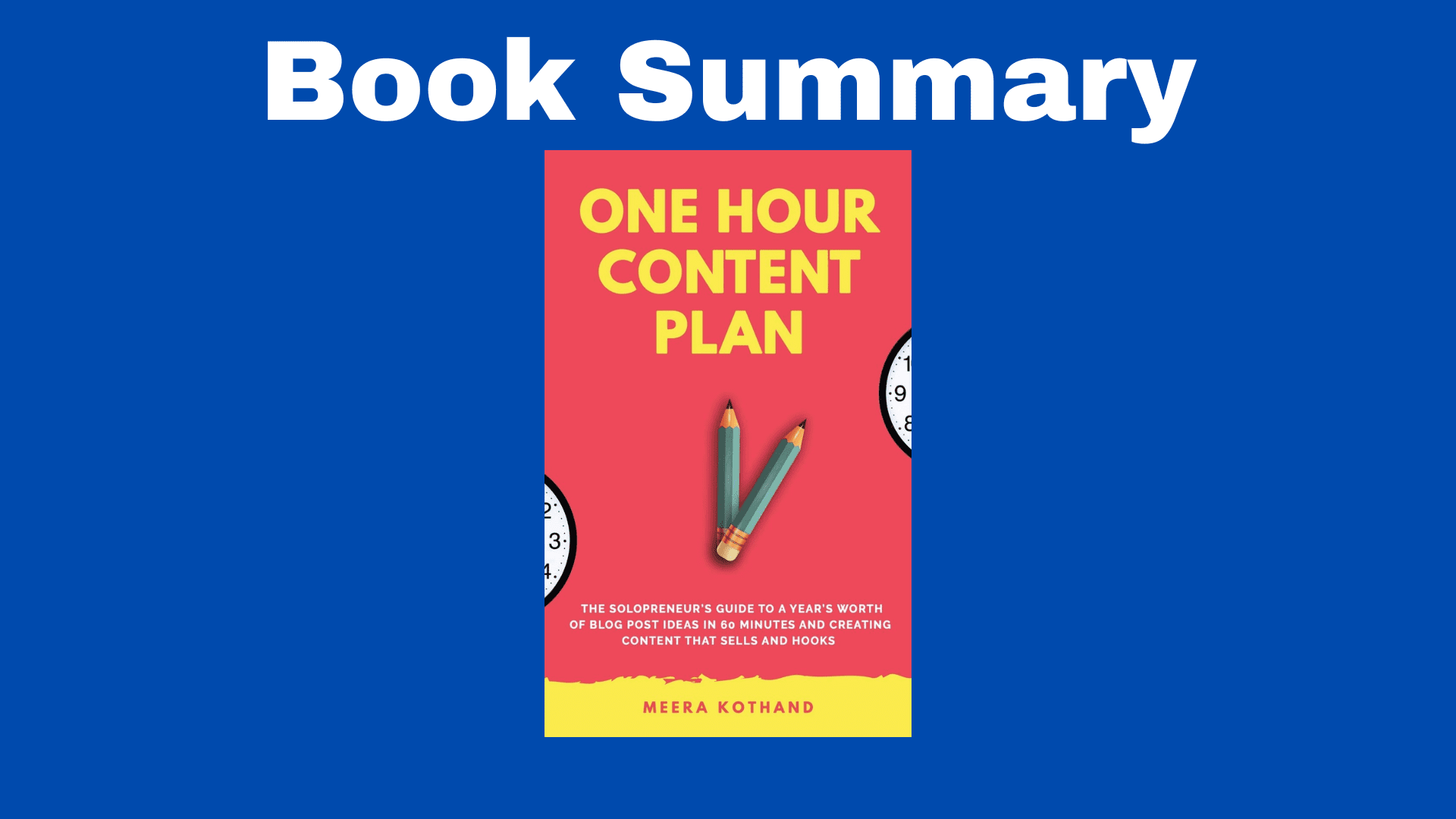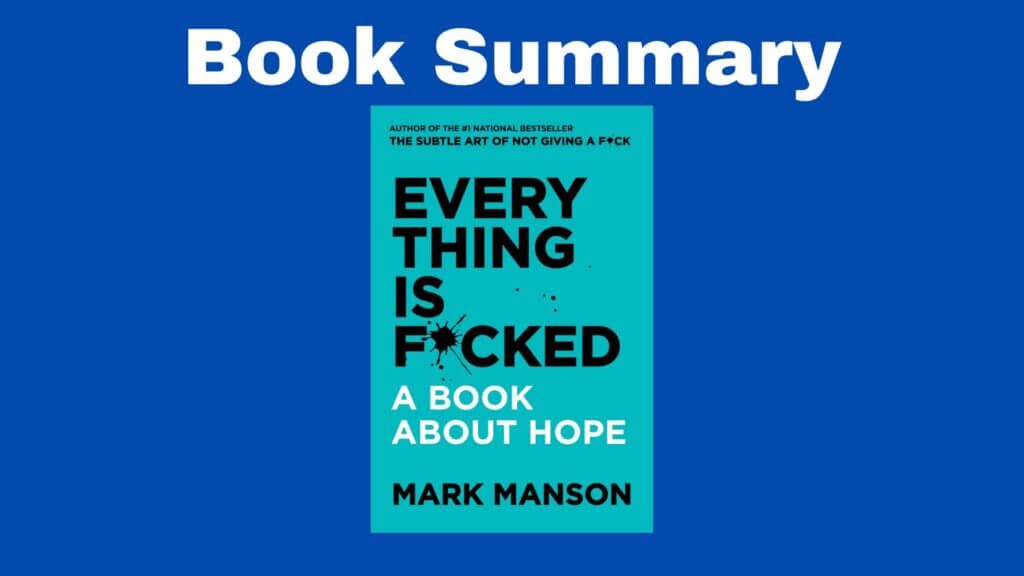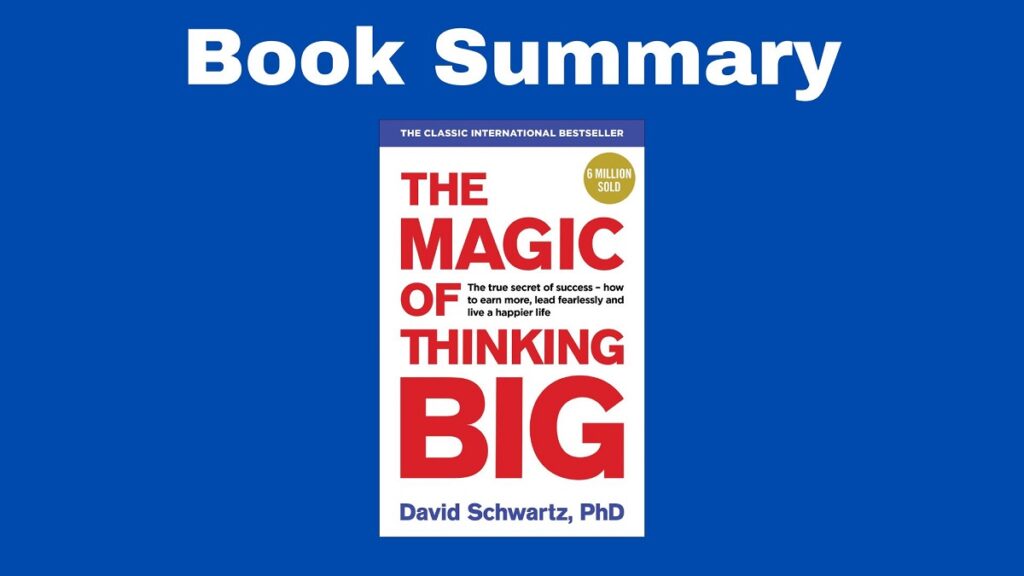The Book in Three Sentences
The One Hour Content Plan offers a strategy to come up with one year worth of blog posts and social media content in an hour. Additionally, the book teaches you how to turn casual readers into buyers. There are many actionable tips, as well as a few forms that you can easily put into practice.
The One Hour Content Plan Summary
Introduction
The book promises a year of blog posts in an hour. To come up with content ideas, a content strategy is necessary.
Signs that you’re in desperate need of a blog content plan:
- You never know what to write
- You chase content trends
- Your content doesn’t relate to the products or services you offer. Always remember that your content should solve your readers’ problems.
Posts can encourage people to buy something, they can entertain, or inspire.
What exactly is a content strategy?
A content strategy is a plan for building an audience by publishing, maintaining, and spreading content that educates, entertains, or inspires and turns random people into fans or customers.
Tangible benefits of a solid content strategy:
- SEO
- Traffic
- Sponsorship opportunities
- Sales
- List growth
Intangible benefits of a content strategy:
- Awareness
- Respect and adoration
- Indirect sales
- Become a thought leader or expert
How the one hour content plan works:
- Your blog is a driver of change for your audience
- The Expert-Goal-Offer method. Create timeless content that empowers readers and helps you sell products and services
- The Attribute Markers – Do’s – Dont’s – Expressions Formula.
- Promote content
Section I
You, as a creator, should be able to articulate the direction you want your content to take your readers.
Chapter I: Define Your Content Playing Field
A niche is a solution to a problem. People want to be better versions of themselves. That could mean:
- Personal development
- Fitness
- Food
- Budgeting/personal finance
- Fashion/beauty
- Lifestyle
- Home decor
- Organization
- Travel
- Outdoor/survival
Our blog should exist for more than money. Always think about your audience.
- What group of people do you want to help?
- In what area do you want to help them? If you can answer this, that becomes your blog’s purpose.
In the Driver of Change model: the content becomes a catalyst for change. This means your content should be transformative. The destination that my content produces is change.
- What are my readers going through?
- What do your readers feel?
- What thoughts run through their minds?
Chapter 2: Find An Imaginary Friend in Your Ideal Reader
Know your ideal reader. In the author’s words: “content that tries to attract everyone, attracts no one.”
By defining the ideal reader, you will:
- Talk to your audience at the right level
- Not waste time on the “wrong” audience
- Have a clear idea of what your content looks like
We’re biologically programmed to like:
- Survival
- Food and beverages
- Freedom from pain/fear
- Sexual companionship
- Comfortable living
- Care about loved ones
- Social Approval
We want to learn:
- To be informed
- To be curious
- To have clean bodies and surroundings
- To be efficient
- To be convenient
- To be dependable
- To express beauty and style
- About economy/profit
- About bargains
How to gather data about your audience without spending any money:
- Search Facebook groups to find readers’ motivations.
- You should also spend time reading comments, especially in blogs other than your own.
- Ask who you already have access to, such as blog subscribers, clients, or followers.
Chapter 3: View Your Content as a Linchpin in the Readers’ Journey
Think about the journey of a reader.
- Stranger
- Casual reader
- Subscriber
- Engaged subscriber and fan
- Brand advocate and customer
Stranger to casual reader: promote content on channels outside the blog, such as social media. Do guest posts, podcasts, create slide shares.
Casual reader to subscriber: offer a compelling lead magnet, such as offering freebies.
Subscriber to engaged subscriber and fan: produce content that empowers and educates.
Engaged subscriber and fan to brand advocate and customer: create content that points in the direction of products or services.
Chapter 4: Position Your Brand and Content in the Online Space
- How different are you from the thousands of blogs in your niche?
- What do you want to be known for?
- What topic/content do you want to be associated with?
The “content tilt” is what separates you from everyone else in your niche?
- What questions is your audience asking and you’re not answering?
- Do you have “strong” opinions in your niche?
- What is everyone saying that isn’t true?
- Are there any methods you use?
- What are common misconceptions people have about your niche?
- What are the biggest light bulb moments you had?
Section II: The One Hour Content Plan
Number of Posts
| 6 Months | 12 Months | |
| Weekly | 26 | 52 |
| Twice a week | 48 | 96 |
| Once every two months | 12 | 24 |
Section III: Content Ideation (Coming Up with Content Ideas)
Swipe File: here you include ideas that inspire and you want to explore further. Divide into categories and include ideas that are aligned with your content GPS.
You can get ideas from
- Facebook Groups
- Buzzsumo
- Podcasts
- Answer the public
- Ubersuggest
- Competitors
Before you do something that has already been done, ask yourself:
- Will my content add something new to the conversation?
- Is it better than what the competition offers? In what way?
From now on the author provides a series of methods to come up with ideas for posts.
Chapter 5: How to Build Content Around Topics that Are Relevant to Your Blog’s Purpose
Break down categories into sub-categories and blog posts.
The expert method: you create content so that the reader becomes “well-versed” or “proficient”. Your reader can’t become an expert with one post, but they can with a series of pieces of content.
Chapter 6: Content Ideas to Promote Your Product and Service Offers
The “offer” method of content ideation has a series of steps:
- The audience has no idea about the problem your product solves, so bring attention to the problem. These are usually posts like “X number of things you didn’t know about X”, or “Why You Should Stop Doing X”.
- The audience becomes aware of the problem. “The Lazy Guide to X”, or “X Ridiculously Simple Shortcuts to X”.
- Once the audience becomes aware of the problem, they trust and love your content.
- In this step, they are ready to buy, but they have some questions
- Hopefully, by this step, they’ve already purchased and want more.
Chapter 7: Goal and Content: A Recipe for Success
This method of coming up with ideas for posts is based on goals. Determine goals and create content around it. Determining goals can be anything from gaining subscribers to making a specific amount of money. You then shape your content around those goals.
Chapter 8: Different Types of Posts to Feed Your Content Ideas
- Myths/pick a fight
- Guides or ultimate posts
- Mistakes
- Trends
- Curated content/roundup posts
- Case studies
- Success and failures
- Useful tools or services
- Interviews
Section IV: The Perfect Content Package
Your content has to attract, delight, and convert.
Chapter 9: Inject content with a powerful brand voice
A “brand voice” is the tone you use to communicate with your audience. To define your brand voice:
- Take a stock. Which posts have a similar tone? Which ones are unique to your style? Which ones sound like they could have been written by someone else?
- What words describe your brand? Which ones don’t?
Chapter 10: What Is the Best Content Format?
Choose the best content format for you. These include video, webinars, blog posts only.
Use the content format you’re most comfortable with. That’s your strength and will attract your audience. Some formats require more time and money, such as podcasting.
Chapter 11: How to Create Smart Blog Posts that Keep Readers Hooked
- Headline.
This is what sells your blog post. When it comes to your headline, you should be clear first and clever second. You should also be specific, you can use minutes, hours, days, or percentages. You can address a specific emotion if you want. Make sure your headline is searchable by including keywords and making it something that people would type into Google.
- Introduction
Your introduction should have a hook, something that grabs the reader’s attention and urge them to keep reading. You can ask the reader a direct question, include a shocking statistic, showcase a benefit or end result, or add a cliffhanger.
- Body of the blog post
Your subheads should pique interest. Use “you” instead of “we” and “I” in your writing. This focuses on the reader. Include trigger words in your body. Use contractions and ask questions to keep readers engaged. Avoid using passive voice. Finally, include links or screenshots to back up your claims.
- Format Your Post for Scanners
Your blog post follows your content style guide interlink to older posts that are relevant.
- Conclusion
Your conclusion has to inspire your readers and encourage them to take action. Make your last few sentences memorable. You can also include a call to action, such as encouraging readers to download content, leave a comment, or share an article. Your conclusion should be 200 words or less.
- Visuals
The images you use are synchronous with your brand, so keep a consistent visual theme. Also, make your images SEO-friendly.
- Sticky assets
Make sharing your posts easy and add related posts. Write a meta description of up to 130 characters. Use short URLs for your pages with target keywords. Don’t forget to include your top keyword several times in your content. Add outbound links to authoritative resources.
Section V: Content Promotional Pathways
- Having a successful blog is 20% about writing content and 80% about promoting it.
- Make your posts “scanner” friendly. Use big text with a font size of 14.
- Add click to tweets.
- Add social share bottoms both at the top and bottom of the post. Show share counts for popular posts.
- When it comes to social media, pick the platforms you use. Don’t include too many platforms, since this can be detrimental.
- Tailor your images for social media.
- In the end, the most important thing you can do is to create good content.
Chapter 12: The Different Promotional Pathways
- Social media
- Outreach
- Automated
- Paid
Section VI: How to Manage Your Editorial Workflow
Chapter 13: Do’s and Dont’s of an Editorial Calendar
- An editorial calendar makes you consistent
- Planning ahead gives you flexibility
- You can make informed decisions
- You see the entire roadmap
Mistakes include
- Not tracking analytics
- Not having a single swipe file
- Not using calendar enough or going by memory
Chapter 14: Tools to Manage an Editorial Workflow
Some of the tools you can use include:
- SEO Pressor’s Blog Title Generator
- For editing you can use the Hemingway App or Grammarly
- For visual marketing, you can use Canva
Conclusion
Traffic, in and of itself, means nothing. Your blog should be about service, community, a digital product, a store, or a membership site. In other words, your blog should be about turning your audience into subscribers.
Further Reading
- Effortless: Make It Easier to Do What Matters Most by Greg McKeown
- Goodbye, Things: The New Japanese Minimalism by Fumio Sasaki
- Hyperfocus: How to Manage Your Attention in a World of Distraction by Chris Bailey
- Minimalism: Live a Meaningful Life by Joshua Fields Millburn and Ryan Nicodemus
- The Productivity Project: Accomplishing More by Managing Your Time, Attention, and Energy by Chris Bailey
- Think Like a Monk: Train Your Mind for Peace and Purpose Every Day by Jay Shetty




